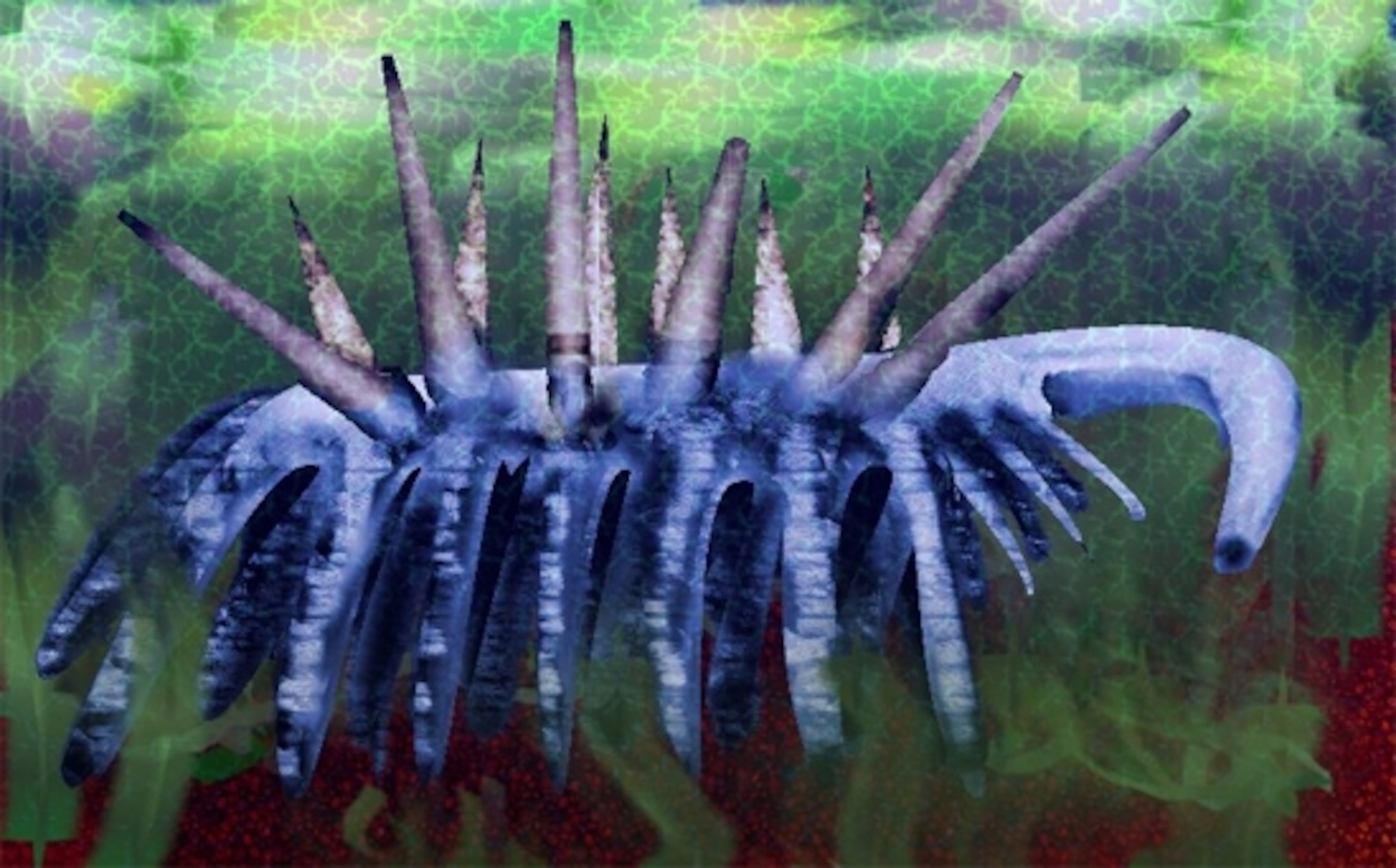
When Hallucinations Walked the World
Imagine learning that scientists had got Tyrannosaurus rex upside-down all this time and, in reality, it slithered on its “back” and waved its legs—sorry, tentacles—in the air. It’d be a bit embarrassing, but it would also never happen. We have some complete Tyrannosaurus skeletons, we can compare these to similar modern animals, and we can simulate the forces that acted upon them. It’s obvious which way up the animal stood.
But not all prehistoric creatures are so easily reconstructed. In 1977, the British palaeontologist Simon Conway-Morris stumbled across a truly bizarre finger-sized fossil, unlike anything that had ever been seen before. It had been found 66 years earlier in the Burgess Shale—a legendary fossil field in the Canadian Rockies—and classified as an annelid worm, the group that includes our familiar earthworms. Conway-Morris thought otherwise.
This thing was weird. Its long trunk had seven pairs of long spines sticking out in one direction and seven of tentacles protruding from the other, with what looked like little mouths on their tips. There was no obvious head, save for a non-descript blob at one end. Conway-Morris named it Hallucigenia because of its “bizarre and dream-like quality”. He suggested that the creature walked along the muddy ocean floor on its stilt-like spines, and grasped food with its tentacles. “That interpretation was quite controversial. It looked like an alien,” says Jean-Bernard Caron from the Royal Ontario Museum in Toronto, who now studies the animal.
Hallucigenia’s true stance only came to light when a related animal called Microdictyon was discovered in China in 1991. These more complete fossils showed that Conway-Morris had been looking at Hallucigenia upside-downlooking at Hallucigenia upside-downlooking at Hallucigenia upside-down. The “tentacles” were legs, and the mouth-like tips were claws. The “legs” were actually spines that protruded from its back, probably for defence. (Although, even now, no one’s entirely sure about the head.)

The discovery of Microdictyon hinted that Hallucigenia wasn’t an isolated oddity from Canada. It was part of a family of bizarre animals—hallucigenids—that may have lived all over the world. Caron has now confirmed as much.
He was studying some Burgess Shale fossils under a powerful microscope, when he noticed that they contained Hallucigenia spines. These were beautifully preserved, and the microscope picked up fine details that the naked eye would never have seen. Each spine is just over a centimetre long can consists of several layers, like an inverted stack of ice-cream cones. On their surfaces, they have hundreds of triangular scales. “That was a big surprise,” says Caron. “Under the microscope, the spines looked highly ornamented.”
These structures are unlike those of any modern animal spine. But Caron, together with Martin Smith and Thomas Harvey, showed that similar spines had been found in fossils all over the world. Many had been assigned to other animal species, but most were a mystery. They could have been plates or shells, or perhaps broken pieces of a limb. Their owners’ bodies had never been found, but Caron’s analysis clearly showed that they were hallucigenid spines. They were short and long, curved and straight, but all of them shared the same structures. And they came from China, Canada, England, Antarctica, Greenland, Australia, Mongolia and Kazakhstan—six continents in total.
All of these fossils hailed from the early Cambrian period, around half a billion years ago. It was an age of weirdos, when animals exploded into a baffling variety of forms. These included the ancestors of today’s species, and many groups that were unlike anything we’re familiar with. (See Carl Zimmer’s wonderful slideshow for more.)
And walking among them were the hallucigenids. According to Caron, their defensive spines were indicative of fierce evolutionary arms races between predators and prey, which kick-started during the Cambrian. “If you have a large group of organisms with spines and plates and so on, there must have been predators around,” he says.
Caron adds that the hallucigenids were probably related to today’s velvet worms. That would also make them ancient cousins of the arthropods—the most successful group of animals on the planet, including insects, spiders, crustaceans and more. If we get a better understanding of the hallucigenids’ bodies, we might get some clues about what the very first arthropods may have looked like.
Reference: Caron, Smith & Harvey. 2013. Beyond the Burgess Shale: Cambrian microfossils track the rise and fall of hallucigeniid lobopodians. Proc Roy Soc B http://dx.doi.org/10.1098/rspb.2013.1613
More on Cambrian life:
- The sharp eyes of Anomalocaris, a top predator that lived half a billion years ago
- Fossil eyes show wraparound three-dimensional vision, half a billion years ago
- Meet Diania the walking cactus, an early cousin of life’s great winners
- Nectocaris: mystery fossil was actually a 500-million-year-old squid relative
